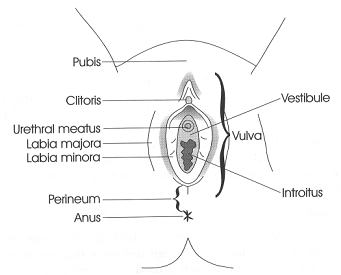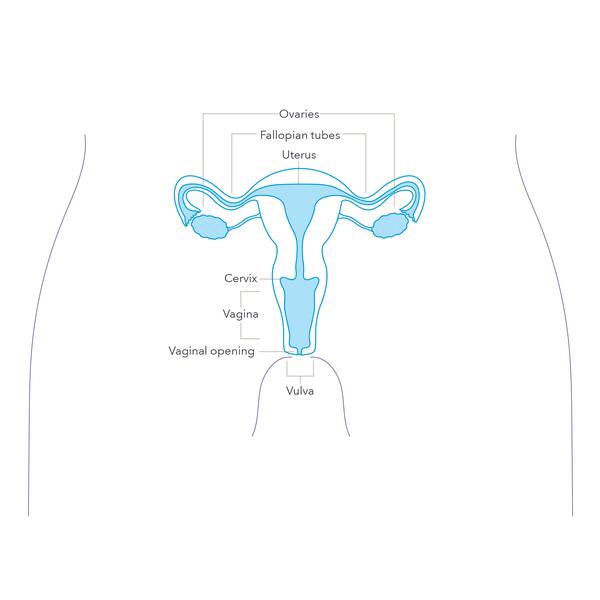Do you know that what some people call vagina is actually the vulva?
Continue reading to know the facts:
The female reproductive system is divided into external and internal parts
We will talk about the main parts of the female reproductive system in this article

Diagram reproduced with permission from The Interstitial Cystitis Survival Guide by Robert Moldwin, MD, New Harbinger Publications, Inc. © 2000.
The external part of the female genitalia is made up of a group of anatomical structures called the vulva
The vulva is what most people mistakenly call the vagina. No two vulvas look the same but they all have the same anatomical structures, which include:
- The Mons pubis – this is the fleshy mound (fatty tissue) above your vulva. It cushions your pubic bone. When a female hits puberty, the Mons begins to grow hair.
- Labia – these are the 2 pairs of skin folds which cover the opening of the vagina. The outer lips are called labia majora which are usually fleshy and covered with pubic hair. The inner lips are called labia minora are inside the outer lips. Labia can be short or long, wrinkled or smooth. Often one lip is longer than the other. They also vary in colour from pink to brownish-black. The colour of your labia can change as you get older. Some people have larger outer lips than inner lips, and many have larger inner lips than outer lips.
- Vestibule – this is the area between the labia minora where the vaginal opening and the urethral meatus are located.
- Urethral meatus – is also called the urethral opening. It is the tiny hole that your urine flows out of, located just below your clitoris.
- Opening of the vagina – This opening is right below your urethral opening. It’s where menstrual blood leaves your body, and babies are born through this opening.
- Clitoris – The tip of the clitoris is located at the top of your vulva, where your inner lips meet. Everyone’s is a different size. It can be about as small a pea or as big as a thumb. The tip of the clitoris is covered by the clitoral hood. It extends inside your body, back and down on both sides of the vagina. Your clitoris is made of spongy tissue that becomes swollen when you’re aroused (turned on). It has thousands of nerve endings — more than any other part of the human body.
- The perineum is the area extending from beneath the vulva to the anus.
The above description shows that what we call the vagina isn’t actually the vagina. All we easily see is the opening to the vagina (introitus)
So, what then is the VAGINA…….drum roollllllllllllllllllllllll!!!!
The internal parts of the female genitalia is made up of these anatomical structures – vagina, cervix, uterus, fallopian tube

Diagram – Planned Parenthood
- Vagina – is an elastic, muscular canal with a soft, flexible lining that provides lubrication and sensation. It connects the uterus and cervix to the outside of the body. That is, it is the tube between the cervix and the vaginal opening. Menstrual blood leaves your body through the vagina. Also because of the elasticity of the vagina, it stretches during childbirth to allow babies out, hence known as a birth canal.
- Cervix – is a cylinder-shaped neck of tissue that connects the vagina and uterus. It is located right between the two. It looks like a donut with a tiny hole in the middle. Menstrual blood flows out of the uterus through this tiny hole into the vagina and sperm swim from the vagina through this tiny hole into the uterus. Your cervix stretches open (dilates) during childbirth.
- Uterus – The uterus is a hollow, pear-shaped muscular organ about the size of a small fist. It is also called the womb because that’s where a fetus grows during pregnancy.
- Ovaries – are small, oval-shaped glands that are located on either side of the uterus. The ovaries store eggs. When a female reaches puberty, her ovaries start to release one or more eggs each month, this continues until menopause. They also produce hormones which control a couple of things including periods and pregnancy.
- Fallopian tubes – These are narrow tubes that are attached to the upper part of the uterus and serve as pathways for the ova (egg cells) to travel from the ovaries to the uterus. Fertilization of an egg by a sperm normally occurs in the fallopian tubes.
Our next article will look more into the vagina[1] !!!





